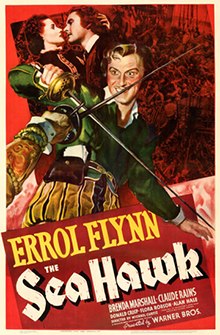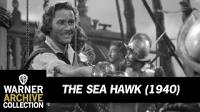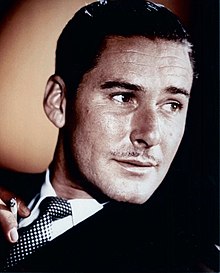I first watched this movie on TV likely sometime after 1954 (when we got our very first Black and White TV) (even though my grandfather in Seattle had bought a big Black and white TV to watch Eisenhower be nominated as President in 1952 and this was the first series of programs I ever watched on TV. So, for a 4 year old in 1952 there was this amazing thing to look at (The Republican Convention) which was all pretty overwhelming and sensory overload for a 4 year old that had NEVER seen a TV before this.
In 1954 my mother, father and mother's mother were all living in Tujunga and I went to first and second Grade at Pinewood Elementary school there before we moved to Glendale when I was 8.
So, Likely I saw this movie first sometime between 1954 and 1959 on our Black and white TV because my mother and Grandmother loved Errol Flynn as an Actor. I think we bought our first Color TV in 1960 or 1962 because color TV wasn't any good at all until then. But, Bonanza and "The Virginian" and eventually Star Trek with William Shatner made it finally worthwhile to actually own a Color TV for the first time.
I DVRed my TIVO a copy from likely Turner Classic Movie Station on Cable TV
Search Results
Main Results
Web results
Web results
Web results
Web results
Related searches
Page Navigation
| 1 | 2 | 3 | 4 | 5 | 6 | 7 | 8 | 9 | 10 | Next |
begin quote from:
The Sea Hawk (1940 film)
| The Sea Hawk | |
|---|---|
 Film poster | |
| Directed by | Michael Curtiz |
| Written by | Howard Koch Seton I. Miller |
| Produced by | Henry Blanke Hal B. Wallis |
| Starring | Errol Flynn Brenda Marshall Claude Rains |
| Cinematography | Sol Polito |
| Edited by | George Amy |
| Music by | Erich Wolfgang Korngold |
| Distributed by | Warner Bros. |
Release date |
|
Running time | 127 minutes |
| Country | United States |
| Language | English |
| Budget | $1,701,211[1][2] |
| Box office | $2,678,000[2] $2 million (US)[3] 3,280,538 admissions (France) (1947)[4] |
The Sea Hawk is a 1940 American adventure film from Warner Bros. that stars Errol Flynn as an English privateer who defends his nation's interests on the eve of the launch of the Spanish Armada. The film was the tenth collaboration between Flynn and director Michael Curtiz. Its screenplay was written by Howard Koch and Seton I. Miller. The rousing musical score by Erich Wolfgang Korngold is recognized as a high point in his career. The film was both an adventure and a period piece about Elizabethan England's struggles with Spain. It was also meant as a deliberately pro-British propaganda film to build morale during World War II and to influence the American public into having a more pro-British outlook. King Philip was presented as an allegorical Hitler. [5] (The same theme had been visited in Alexander Korda's film Fire Over England, released three years earlier, before World War II started).[6]
Colorized versions of The Sea Hawk were broadcast on American television and distributed on VHS tape in 1986. Only the black-and-white, edited version (109 minutes) and the fully restored/uncut version (127 minutes) have been released on the DVD and Blu-ray formats. No plans have been announced to release the colorized version on DVD.
Contents
Plot[edit]
King Philip II of Spain (Montagu Love) declares his intention to destroy England as a first step to world conquest. He sends Don Álvarez (Claude Rains) as his ambassador to allay the suspicions of Queen Elizabeth I (Flora Robson) about the great armada he is building to invade England. In England, some of the queen's ministers plead with her to build a fleet, which she hesitates to do in order to spare the purses of her subjects.
The ambassador's ship is captured en route to England by the Albatross and her captain, Geoffrey Thorpe (Errol Flynn). Don Álvarez and his niece Doña María (Brenda Marshall) are taken aboard and transported to England. Thorpe immediately is enchanted by Doña María and gallantly returns her plundered jewels. Her detestation of him softens as she too begins to fall in love.
Don Álvarez is granted an audience with the queen and complains about his treatment; Doña María is accepted as one of her maids of honour. The "Sea Hawks", a group of English privateers who raid Spanish merchant shipping, appear before the queen, who scolds them (at least publicly) for their activities and for endangering the peace with Spain. Captain Thorpe proposes in private a plan to seize a Spanish treasure fleet coming back from Spain's colonies in the Americas. The queen is wary of Spain's reaction, but allows Thorpe to proceed.
Suspicious, Lord Wolfingham (Henry Daniell), one of the queen's ministers and a secret Spanish collaborator, sends a spy to try to discover where the Albatross is really heading. Upon visiting the chartmaker responsible for drawing the charts for Thorpe's next voyage, Don Álvarez and Lord Wolfingham determine that he is sailing to the Isthmus of Panama and order the captain of Don Álvarez's ship to sail ahead to set up an ambush.
When the Albatross reaches its destination, the ship is spotted by a native who reports it to the Spanish governor. Thorpe's crew seizes the caravan, but fall into a well-laid trap and are driven into the swamps. Thorpe and a few other survivors return to their ship, only to find it in Spanish hands. They are taken to Spain, tried by the Inquisition, and sentenced to life imprisonment as galley slaves. In England, Don Álvarez informs the queen of Thorpe's fate, causing his niece to faint. The queen and Don Álvarez exchange heated words, and she expels him from her court.
On a Spanish galley, Thorpe meets an Englishman named Abbott, who was captured trying to uncover evidence of the Armada's true purpose. Through cunning, the prisoners take over the ship during the night. They board another ship in the harbor, where an emissary has stored secret incriminating plans. Thorpe and his men capture both and sail back to England with the plans.
Upon reaching port, Thorpe tries to warn the queen. A carriage bringing Don Álvarez to the ship which, unknown to him, Thorpe has captured, also brings his niece. Don Álvarez boards the ship and is held prisoner, while Captain Thorpe, dressed in the uniform of a Spanish courtier, sneaks into the carriage carrying Doña María, who has decided to stay in England and wait for Thorpe's return. The two finally declare their love for each other, and María helps Thorpe to sneak into the palace. However, Lord Wolfingham's spy spots Thorpe and alerts the castle guards to stop the carriage and take Thorpe prisoner. Thorpe escapes and enters the queen's residence, fending off guards all the while.
Eventually, Thorpe runs into Lord Wolfingham and kills the traitor in a swordfight. With Doña María's assistance, Thorpe reaches the queen and provides proof of King Philip's intentions. Elizabeth knights Thorpe and declares her intention to build a great fleet to oppose the Spanish threat.
Cast[edit]
- Errol Flynn as Geoffrey Thorpe
- Brenda Marshall as Doña María
- Claude Rains as Don José Álvarez de Córdoba
- Donald Crisp as Sir John Burleson
- Flora Robson as Queen Elizabeth of England
- Alan Hale as Carl Pitt
- Henry Daniell as Lord Wolfingham
- Una O'Connor as Miss Latham, Doña María's English duenna
- James Stephenson as Abbott
- Gilbert Roland as Captain López, Don José's sea captain
- William Lundigan as Danny Logan
- Julien Mitchell as Oliver Scott
- Montagu Love as King Philip II of Spain
- J. M. Kerrigan as Eli Matson
- David Bruce as Martin Burke
- Clifford Brooke as William Tuttle
- Clyde Cook as Walter Boggs
- Fritz Leiber as Inquisitor
- Ellis Irving as Monty Preston
- Francis McDonald as Samuel Kroner
- Pedro de Córdoba as Captain Mendoza
- Ian Keith as Peralta
- Jack La Rue as Lieutenant Ortega (as Jack LaRue)
- Halliwell Hobbes as Astronomer
- Alec Craig as Jodocus Hondius
- Victor Varconi as General Aguirre
- Robert Warwick as Captain Frobisher
- Harry Cording as Slavemaster
- Leyland Hodgson as Officer
- Leo White as Bit Role (uncredited)
- Edgar Buchanan as Ben Rollins (uncredited)
Production[edit]
The portions of the film set in the Panama are tinted sepia.[7]
The film was announced in June 1936 and would star Errol Flynn, then coming off his success with Captain Blood.[8]
Originally planned as an adaptation of Rafael Sabatini's 1915 novel The Sea Hawk, the film used an entirely different story inspired by the exploits of Sir Francis Drake,[9] unlike the 1924 silent film adaptation, which was fairly faithful to Sabatini's plot (which, in turn, was very similar to the plot of Captain Blood).
Adaptations of the novel were written by Richard Neville and Delmer Daves before Seton I Miller wrote a basically new story titled Beggars of the Sea based on Sir Francis Drake. Sabatini's name was still used in promotional materials however as it was felt it had commercial value. Howard Koch then reworked Miller's script while still keeping the basic structure and story.[1][10]
The speech the queen gives at the close of the film was meant to inspire the viewing British audience, which was already in the grip of the Second World War. Suggestions that it was the duty of all free men to defend liberty, and that the world did not belong to any one man (an obvious insinuation of Hitler's wish to conquer Europe), were rousing.
The 2005 Warner Brothers DVD release includes a 1940 Movietone News newsreel of the Battle of Britain, the short "Alice in Movieland," the Looney Tunes cartoon "Porky's Poor Fish", and a 20-minute featurette "The Sea Hawk: Flynn in Action" about the film's production.
Music[edit]
The music was written by composer Erich Wolfgang Korngold. When The Sea Hawk opened in theatres, a commercial recording was not contemplated. It was not until 1962 that a bit of music from the film was released on an LP titled Music by Erich Wolfgang Korngold. Ten years later Charles Gerhardt and Korngold's son George included 6:53 minutes of The Sea Hawk score on RCA's album The Classic Film Scores of Erich Wolfgang Korngold. A complete re-recording was issued in 2007 by the Naxos label, recorded with the Moscow Symphony Orchestra and Chorus led by William T. Stromberg [it] and reconstructed by John W. Morgan.
Reception[edit]
Critical[edit]
Bosley Crowther wrote in The New York Times of 10 August 1940,
"Of course, [the film] is all historically cockeyed, and the amazing exploits of Mr. Flynn, accomplished by him in the most casual and expressionless manner, are quite as incredible as the adventures of Dick Tracy. But Flora Robson makes an interesting Queen Elizabeth, Claude Rains and Henry Daniell play a couple of villainous conspirators handsomely, there is a lot of brocaded scenery and rich Elizabethan costumes and, of course, there is Brenda Marshall to shed a bit of romantic light. And, when you come right down to it, that's about all one can expect in an overdressed 'spectacle' film which derives much more from the sword than from the pen."[11]
A review by Time on 19 August 1940 observed that:
"The Sea Hawk (Warner) is 1940's lustiest assault on the double feature. It cost $1,700,000, exhibits Errol Flynn and 3,000 other cinemactors performing every imaginable feat of spectacular derring-do, and lasts two hours and seven minutes...Produced by Warner's Hal Wallis with a splendor that would set parsimonious Queen Bess's teeth on edge, constructed of the most tried-&-true cinema materials available, The Sea Hawk is a handsome, shipshape picture. To Irish [sic] Cinemactor Errol Flynn, it gives the best swashbuckling role he has had since Captain Blood. For Hungarian Director Michael Curtiz, who took Flynn from bit-player ranks to make Captain Blood and has made nine pictures with him since, it should prove a high point in their profitable relationship."[12]
Filmink called it "pretty close to perfection as these things go."[13] This movie has a one hundred percent rating based on twelve critic reviews on Rotten Tomatoes.
Box office[edit]
The film had been in planning since Errol Flynn's success in the swashbuckler epic Captain Blood.[14] According to Warner Bros records, the film was Warners' most expensive and most popular film of 1940. It made $1,631,000 in the U.S. and $1,047,000 in other markets.[2] Upon release in 1940, the film was among the higher grossing films of the year, and in several states (including Florida, Alabama, Georgia, South Carolina, North Carolina and Virginia) it was the highest grossing film of the year, and in several others (including Tennessee, Mississippi, Kentucky and Arkansas), it was the second highest grossing film of the year, coming behind Rebecca.
1947 re-release[edit]
The film was re-released to great popularity in 1947.[10] It was one of the more popular films that screened in France that year.[4]
Awards[edit]
The film was nominated for four Academy Awards:[15]




No comments:
Post a Comment